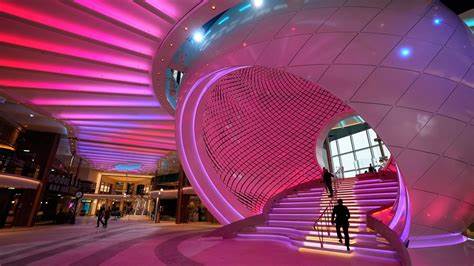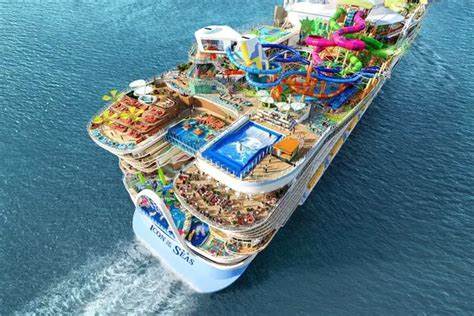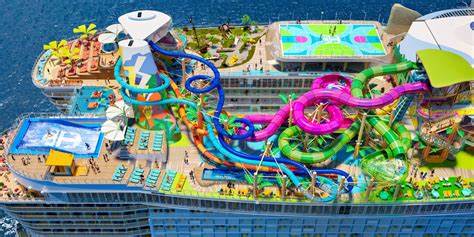The world’s largest cruise ship, the Icon of the Seas, recently embarked on its maiden voyage from Miami, Florida, drawing attention not only for its impressive size but also for environmental concerns regarding methane emissions. This 365-meter-long vessel, owned by Royal Caribbean Group, boasts 20 decks and a capacity for up to 7,600 passengers. As it sets sail for a seven-day Caribbean cruise, environmentalists express worries about the potential environmental impact of its liquefied natural gas (LNG) propulsion system.
The Icon of the Seas: A Marvel of Engineering and Luxury

Built at a shipyard in Turku, Finland, at a cost of $2 billion (£1.6 billion), the Icon of the Seas is a floating city on water. Registered in the Bahamas, it offers an array of amenities, including seven swimming pools, six water slides, over 40 restaurants, bars, and lounges. With a focus on providing a luxurious experience for passengers, the ship represents a significant investment in the cruise industry’s future.
Environmental Concerns Surrounding LNG Propulsion
While LNG is considered a cleaner alternative to traditional marine fuels, concerns arise regarding potential methane emissions. The vessel’s LNG-powered engines are designed to burn more cleanly, but there is a risk of gas leakage, leading to the release of methane—a potent greenhouse gas that traps heat in the atmosphere more effectively than carbon dioxide. Environmentalists caution that despite the cleaner combustion process, any escaping gas could contribute to climate change.
The Methane Debate: Assessing the Environmental Impact

Environmental experts, including Bryan Comer from the International Council on Clean Transportation (ICCT), express reservations about the use of LNG in marine fuels. Comer suggests that LNG may emit over 120% more life-cycle greenhouse gas emissions than traditional marine gas oil. A recent ICCT report challenges current regulations, arguing that methane emissions from LNG-fueled ships might be higher than assumed, posing a significant challenge in mitigating climate change.
Royal Caribbean’s Perspective and Energy Efficiency Commitments
Royal Caribbean responds to these concerns, stating that the Icon of the Seas exceeds the energy efficiency standards set by the International Maritime Organization. The company emphasizes that the ship is 24% more energy-efficient than required, showcasing its commitment to environmental responsibility. Moreover, Royal Caribbean outlines plans to introduce a net-zero ship by 2035, indicating a long-term commitment to sustainable practices within the cruise industry.
The Cruise Industry’s Growing Impact

The cruise industry has become a powerhouse within the tourism sector, contributing significantly to the global economy. According to the Cruise Lines International Association, the industry contributed $75 billion (£59 billion) to the global economy in 2021. The allure of cruise holidays, particularly among young people, has fueled the industry’s rapid growth, making environmental considerations increasingly vital.
Methane’s Environmental Impact: A Closer Look
Methane, while more potent than carbon dioxide in the short term, remains a crucial target for emissions reduction efforts. With its capacity to trap 80 times more heat than carbon dioxide over 20 years, addressing methane emissions is vital in the fight against global warming. The cruise industry’s adoption of LNG as a cleaner fuel source brings attention to the broader challenge of balancing growth with environmental sustainability.
Balancing Luxury and Responsibility: The Industry Dilemma

The Icon of the Seas epitomizes the cruise industry’s ongoing dilemma—balancing the demand for luxury experiences with the need for environmental responsibility. As cruise companies invest in larger and more extravagant vessels, finding sustainable propulsion solutions becomes imperative. The industry must grapple with evolving environmental standards, public scrutiny, and the pressing need to curb emissions.
Lionel Messi’s Involvement and Symbolic Traditions
As the Icon of the Seas set sail, it had a special participant in its naming ceremony—Argentina’s football icon Lionel Messi. The football star, currently playing for Inter Miami, took part in the traditional naming ceremony, symbolized by breaking a champagne bottle against the ship’s bow for good luck. Messi’s involvement underscores the intersection of sports, entertainment, and the cruise industry’s global appeal.
Looking Ahead: A Sustainable Future for Cruise Travel
The maiden voyage of the Icon of the Seas serves as a catalyst for discussions surrounding the environmental impact of the cruise industry. While concerns about methane emissions persist, the industry’s commitment to cleaner technologies and energy-efficient practices indicates a willingness to address environmental challenges. As the cruise industry navigates these waters, the Icon of the Seas represents both the epitome of luxury and a symbol of evolving responsibility in an era focused on sustainable travel.





